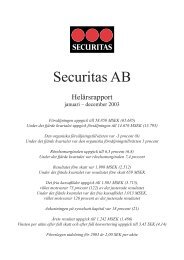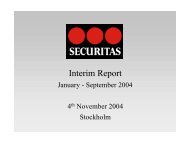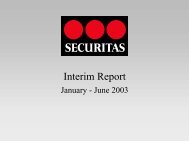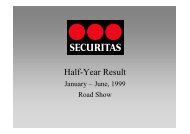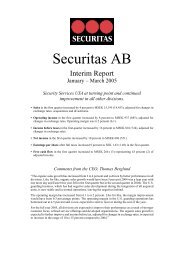Securitas AB Annual Report 2005
Securitas AB Annual Report 2005
Securitas AB Annual Report 2005
You also want an ePaper? Increase the reach of your titles
YUMPU automatically turns print PDFs into web optimized ePapers that Google loves.
From multi-service providers to security specialists<br />
Multi-service Focus on Security Consolidation Specialization Differentiation<br />
Security<br />
Staffi ng<br />
Corrections<br />
Rescue<br />
Care<br />
Locks<br />
Cleaning<br />
Maintenance<br />
Health<br />
Catering<br />
Parceel<br />
Guards<br />
Alarms<br />
Cash handling<br />
Corrections<br />
Rescue<br />
Care<br />
Staffi ng<br />
Locks<br />
Size<br />
Guards<br />
Alarm<br />
Cash handling<br />
Corrections<br />
Rescue<br />
Decades ago, security was often just one part of a multi-service company or conglomerate. Priorities were based on the overall<br />
requirements of these groups, and security was of secondary importance. Since then, an independent security industry has been<br />
created in which most of the main players are solely focused on security. Guarding and cash handling services have since become<br />
independent businesses, while both alarm companies and conglomerates are driving the alarm business.<br />
From multi-service<br />
providers to security specialists<br />
The industry previously had a highly fragmented<br />
structure dominated by multi-service providers and<br />
conglomerates and a large number of small local players.<br />
Since the mid-1980s <strong>Securitas</strong> has been a pioneer<br />
by focusing strictly on security. Management and the<br />
Board of Directors decided at the time that developing<br />
a skilled workforce and specialization was the way to<br />
generate profi table, income- and quality-driven growth.<br />
Four streamlined security players have gained a growing<br />
share of the market in the last 15 years, in the USA from<br />
approximately 30 percent to 45 percent and in Europe<br />
from 15 percent till 35 percent.<br />
Professional services<br />
Professional services require professional people. The<br />
industry’s development is therefore dependent upon its<br />
ability to develop employees into professional security<br />
specialists. The key factors are recruitment of the right<br />
people, better training and the right wages. Today the<br />
security profession can no longer be viewed as a fi eld<br />
dominated by temporary staff, high turnover and low<br />
wages. The greater competence exhibited by employees<br />
goes hand-in-hand with the increasing confi dence customers<br />
have shown in the industry and what it can accomplish,<br />
which is expanding the market’s potential.<br />
Higher demand for quality and more specifi c security<br />
services is also driving the development of standards,<br />
laws, rules and norms. Though sometimes signifi cantly<br />
different between countries, they essentially determine<br />
the qualifi cations for security companies, how to verify<br />
the background of employees and training requirements.<br />
Guards<br />
Cash handling<br />
Alarm<br />
Knowledge<br />
Security solutions<br />
– Large specialized<br />
– Small specialized<br />
Large systems<br />
– Banks<br />
– Retailers<br />
– Integration<br />
Direct<br />
– Consumer alarms<br />
– Local business alarms<br />
Cash handling<br />
– Transport<br />
– Processing<br />
– Management<br />
These standards are continuously being developed, which<br />
is further raising the level of quality and professionalism<br />
in the industry.<br />
<strong>Securitas</strong> has continued to drive the industry towards<br />
greater specialization and segmentation. This is why<br />
the Group has been organized in fi ve divisions, each<br />
of which develops independently with differentiated<br />
customer needs and markets. Guarding services are<br />
combined with technological security systems and<br />
consulting, and needs are developing differently for<br />
small and large customers. In alarm systems, customer<br />
needs are being segmented by industry. The market for<br />
home security is growing rapidly with increasingly<br />
sophisticated technology. In the area of cash handling,<br />
there are two completely different markets in banking<br />
and retail, each requiring specifi c cash management<br />
solutions.<br />
From size to knowledge<br />
The future development of the security industry today<br />
seems fairly clear. The industry is dominated by a few,<br />
large internationally active security specialists that in<br />
certain segments face local and regional competition<br />
from niche players. Size is no longer the biggest competitive<br />
advantage. The decisive factor will be a critical<br />
mass of knowledge and the ability to create innovative<br />
solutions that provide greater benefi ts for customers in<br />
increasingly specialized segments.<br />
Market<br />
SECURITAS <strong>2005</strong> 17




